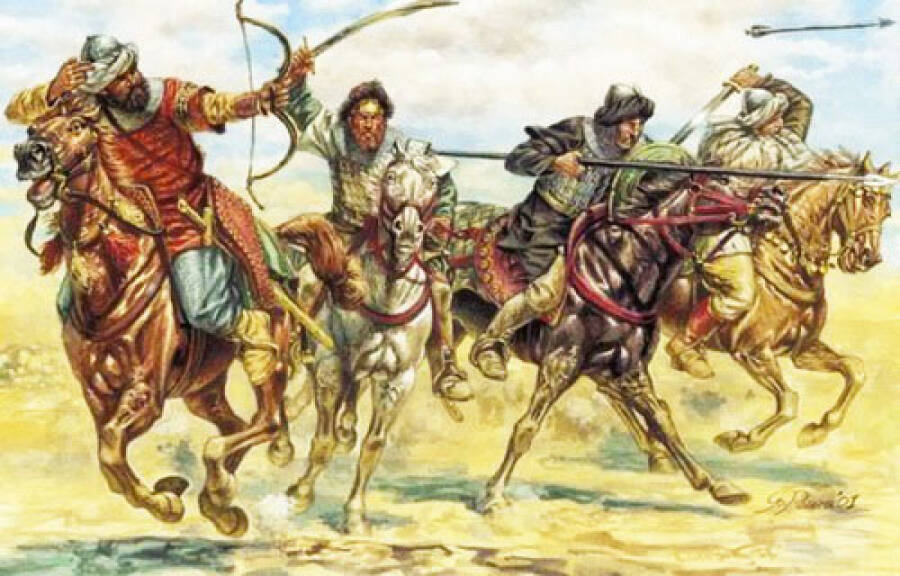For history buffs it is no secret that at a certain stage of its existence Khazar Khaganate adopted Judaism as the state faith. But the circumstances of this decision for most readers is a mystery — as our distant ancestors said, dark water in the clouds. Therefore, the author will try to dispel it, and tell why and how the Khazars became Jews.

Khazaria separated in the middle of the 7th century, when the Chinese defeated the Western Turkic Kaganate, the center of which was located in Central Asia. This led to the independence of the nomads of the Northern Black Sea region, who conquered the surrounding tribes and founded their own steppe empire.
At that time, the main powers in the region were Byzantium and the Arab Caliphate. Each of the great powers was actively spreading their religion, but to accept it meant to submit in the political sense. And then the Khazars decided to make a move to take a more advanced culture, which was a constant companion to the faith, but retain complete independence.
Children of Zion appeared in Eastern Europe in the 6th century, when the Sassanid state conquered Caucasian Albania and founded many new cities and fortresses on its territory. Among other things, Persians and Jews from Mesopotamia were resettled here and gradually established long-distance trade.
In the next century, under the patronage of the Khazars, they have already penetrated into the Lower Dnepr and started commercial relations with the Varangians. There were significant Jewish communities in Belenjer, Itil, Sarkel, Semender, and perhaps even in Khazar Kiev. Not surprisingly, many nomadic leaders converted to Judaism under their influence. But its final establishment as the state religion of the Khazar Khaganate took place in the late 8th — early 9th century under Kagan Obadiah — the first of the monarchs of his state who bore a Jewish rather than a Turkic name.

In the letter of the Khazar king Joseph ben Aaron, sent to a Jewish official of the Caliphate of Cordoba, it is indicated that Obadiah was from among the sons of the general and the first ruler of all the Khazars — Bulan. However, the phrase is formulated in such a way that doubts arise. It could be implied here that Obadiah was not the son of the Khagan, but his descendant.
Before him, Khazar monarchs did not make special efforts to convert the subject population to the new faith, although Bulan was already a Jew. Moreover, from the position of Judaism, they professed an unorthodox version of this religion, for they did not hold services, did not know rabbis and did not have synagogues.
But Obadiah, who was a contemporary of Caliph Harun al-Rashid, carried out reforms. His activities, supported by the Jewish Radhonite merchants, are sometimes interpreted as a coup d’état. Spiritual schools and houses of prayer were built, rabbis began to take care of observing all the many rules of their religion. Jews from all over the Islamic world and their countrymen from the Eastern Roman Empire came to the Khazar cities.
With reliance on them, the Bulanid dynasty managed to significantly strengthen its power and established a system of dual rule. The Kagan of the Ashin family (as in the Turkic Kaganate) became a sacral but powerless figure. He was regarded as a living god, but at the slightest problems he was sent to the other world, being replaced by the nearest relative. Here, as well as in Slavic principalities, the principle of succession to the throne was based on the right of succession, i.e. the throne was given not to the eldest son of the Kagan, but to the eldest in the family.

However, actually the state was ruled by descendants of Bulan and Obadia. They transferred the powers according to the law of majorate — from the father to the senior son that allowed to keep and centralize authority. The Bulanids were real, not nominal monarchs, and bore the Semitic title melek, meaning “king.”
According to historians, such reforms were carried out not only to contrast the Jewish Khazaria with the Orthodox Byzantium and the Muslim Arab Caliphate. The main task was to push back the pagan gods, on which the authority of the Kagans of the Ashin dynasty rested. And, thus, to consolidate the power of the Jewish ruling family.
Obadiah made some efforts to spread his faith. He carried out reprisals against the inhabitants of Christian Crimean cities, who as a result withdrew from the Khazars and preferred to submit to their co-religionists, the Greeks. In addition, the migration of Magyar nomads to the Danube, which culminated in the creation of the Kingdom of Hungary, is often attributed to a desire to preserve paganism.

One way or another, Obadiah founded his own dynasty of kings — his descendants ruled the country until its fall. They managed to seriously strengthen the state, but slept through the strengthening of Ancient Russia. Having united with all the enemies of Khazaria from the Hungarians to the Pechenegs, the Varangians managed to inflict a crushing blow to the steppe empire.
